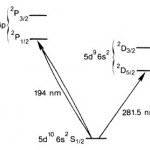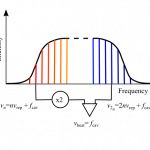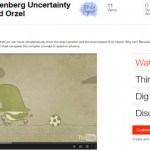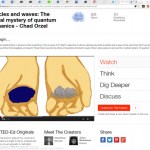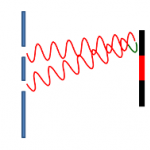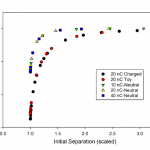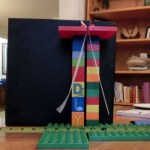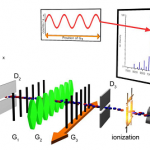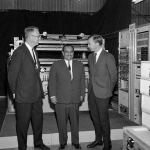Atoms and Molecules
Over at Backreaction, Bee has a nice piece on our current age of virality. Toward the end, she discusses some of the ways this applies to science, specifically a quote from this Nature article about collaborative efforts to measure "big G", and a story about a Chinese initiative to encourage collaboration. She writes of the latter, "Essentially, it seems, they’re giving out salary increases for scientists to think the same as their colleagues."
And I agree that this can be a problem-- there's a famous paper I can never find looking at the evolution of the accepted value of some physical…
The third of the videos I wrote for TED-Ed is now live: Schrödinger's Cat: A Thought Experiment in Quantum Mechanics.This is using basically the same argument I outlined in this post, but with awesome animation courtesy of Agota Vegso. I'm impressed by how close the images that ended up in the video are to the pictures I had in my mind while I was writing it.
As I said in that old post, I dithered for a bit about whether to run with this argument, but decided I liked it enough to go ahead. You can legitimately quibble about some of the phrasing being a little too definite (or that Schrödinger…
The 2014 Nobel Prize in Physics has been awarded to Isamu Akasaki, Hiroshi Amano and Shuji Nakamura for the development of blue LED's. As always, this is kind of fascinating to watch evolve in the social media sphere, because as a genuinely unexpected big science story, journalists don't have pre-written articles based on an early copy of a embargoed paper. Which means absolutely everybody starts out using almost the exact words of the official Nobel press release, because that fills space while they frantically research the subject. Later in the day, you'll get some different framing, once…
In a weird coincidence, shortly after I wrote a post about "quantum leap" as a metaphor, I was looking up some stuff about John Bell and ran into mentions of a paper he wrote called "Are There Quantum Jumps?" Bell is borrowing a title from Schrödinger, who wrote a pair of articles (really, one article in two pieces) for the British Journal for the Philosophy of Science in 1952 expressing his discontent with the entire idea of "quantum jumps" between states. Bell even opens his paper with a quote from Schrödinger: "If we have to go on with these damned quantum jumps, then I'm sorry that I ever…
On Twitter Sunday morning, the National Society of Black Physicsts account retweeted this:
Using Lasers to Lock Down #Exoplanet Hunting #Space
http://t.co/0TN4DDo7LF
— ✨The Solar System✨ (@The_SolarSystem) September 28, 2014
I recognized the title as a likely reference to the use of optical frequency combs as calibration sources for spectrometry, which is awesome stuff. Unfortunately, the story at that link is less awesome than awful. It goes on at some length about the astronomy, then dispenses with the physics in two short paragraphs of joking references to scare-quoted jargon from the…
The second one of the TED-Ed lessons I wrote about quantum physics has now been published: What Is the Heisenberg Uncertainty Principle. This is, again, very similar to stuff I've written before, specifically this old blog post and the relevant chapter of How to Teach [Quantum] Physics to Your Dog.
As usual, I tried but probably failed to do justice to other interpretations in the "Dig Deeper" references I sent; outraged Bohmians should feel free to comment either here or there with better explanations.
Again, it's really fun to see the images the animators found to put to my words. I love…
My TED@NYC adventure last fall didn't turn into an invite to the big TED meeting, but it did lead to a cool opportunity that is another of the very cool developments I've been teasing for a while now: I've written some scripts for lessons to be posted with TED-Ed. The first of these, on particle-wave duality just went live today.
The content here is very similar to my talk last fall, which is, in turn, very similar to Chapter 8 of Eureka: a historical survey of the development of quantum physics. I did the script for this, which was then turned over to professional animators, who did a great…
I didn't write a summary of the third day of "Quantum Boot Camp" to go with my Day One and Day Two summaries for a simple reason: I would've needed to do that on Saturday, and I spent Saturday in transit back to the US. More than that, though, it was harder to summarize than the other two days, because my talk was the middle of three, and thus I spent most of the first talk fiddling with my slides and fretting, and most of the third fighting off the post-talk adrenaline crash.
Happily, Sedeer at Inspiring Science offers a summary of the first two talks, namely Larus Thorlacius from Nordita…
The latest in a long series of articles making me glad I don't work in psychology was this piece about replication in the Guardian. This spins off some harsh criticism of replication studies and a call for an official policy requiring consultation with the original authors of a study that you're attempting to replicate. The reason given is that psychology is so complicated that there's no way to capture all the relevant details in a published methods section, so failed replications are likely to happen because some crucial detail was omitted in the follow-up study.
Predictably enough, this…
I'm working on some short pop-quantum explainers for reasons that I'll be a little cagey about. In casting around for a novel way to introduce Schrödinger's cat states, I hit on something that probably works, but illustrates the problems inherent in being both a professional physicist and a pop-science writer.
The hook, as I mentioned on Twitter a little while back (early on a weekend morning, so nobody read it) is that you have Schrödinger's cat to thank for the computer you're reading this on. The core idea of the infamous cat paradox is that it's both alive and dead at the same time,…
A little while back, I was put in touch with a Wall Street Journal writer who was looking into a new-ish health fad called "earthing," which involves people sleeping on special grounded mats and that sort of thing. The basis of this particular bit of quackery is the notion that spending time indoors, out of contact with the ground, allows us to pick up a net positive charge relative to the Earth, and this has negative health consequences. Walking barefoot on the ground, or sleeping on a pad that is electrically connected to ground via your house's wiring, allows you to replace your lost…
A diabolical psychologist brings a mathematician in for an experiment. The mathematician is seated in a chair on a track leading to a bed on which there is an extremely attractive person of the appropriate gender, completely naked. The psychologist explains "This person will do absolutely anything you want, subject to one condition: every five minutes, we will move your chair across one-half of the distance separating you."
The mathematician explodes in outrage. "What! It'll take an infinite time to get there. This is torture!" They storm out.
The next experimental subject is a physicist,…
Another Monday, another recap of a new episode of the Cosmos reboot. This one was all about optics, and much of it was excellent. This was in part due to the fact that its first couple of historical segments focused on non-Western figures, and I don't know as much about their background to be able to nitpick. First up was Mozi, a Chinese philosopher from circa 400BCE, who may have been the first to demonstrate the camera obscura technique of projecting images from a pinhole in the wall of a dark room. He was followed by ibn al-Haytham, circa 1000CE, who did the first fairly complete analysis…
Topping the looooong list of things I would give a full ResearchBlogging write-up if I had time is this new paper on a ultra-cold atom realization of "Dirac Monopoles". This is really cool stuff, but there are a lot of intricacies that I don't fully understand, so writing it up isn't a simple matter.
The really short version, though, is that a team of AMO physicists have created particles that are analogous to magnetic monopoles-- that is, to a particle that was only a "north" or "south" pole of a magnet, not both together like a conventional bar magnet (leading to my favorite social-media…
I realize people are getting sick of reading me talk about this charged-tape business, which has run to one, two, three, four posts at this point. Truth be told, I'm losing enthusiasm for it myself. So this will be the final post, at least for now...
As I mentioned on Twitter, as I type this stuff up for the blog, I've toyed with the idea of hanging onto it instead, and writing it up for The American Journal of Physics or The Physics Teacher, so I could get a little professional credit for it. There are two problems with that (other than that some stick-in-the-mud editor or reviewer might…
The very last section of the book-in-progress (at least the draft that's with my editor right now...) is titled "Science Is Never Over," and talks about how there are a nearly infinite number of phenomena that you can investigate scientifically. The universe is a never-ending source of amazement and wonder, with surprisingly rich dynamics in the simplest of things. I mean, look at the thousands of words I've gotten out of talking about sticky tape...
This is why I sigh heavily whenever I see a title like Ashutosh Jogalekar's "Should Physicists Stop Looking for Fundamental Laws. This is, at…
In addition to making a toy model to show the tipping-point behavior of charged pieces of sticky tape, I spent some time on Tuesday trying to do something quantitative with this. Of course, Tuesday is the one day of the week that I don't teach, and I didn't want to go to campus to do the experiment, so I put it together from the incredibly sophisticated materials I had available at home: Lego bricks and a tape measure belonging to SteelyKid and The Pip.
Having built this high-tech rig, I set up my new video camera on the tripod, and shot some videos of the key phenomena. First, there's the…
I know I said there weren't going to be physics posts for a while, but yesterday our Communications office passed along a media request about this paper on feedback cooling of BEC, from some sort of communications-person mailing list. I'd seen it talked up elsewhere-- here, for example, so I banged out an email to the reporter in question. Who didn't use any of my stuff in the story that ran late last night.
Having put in the work, though, I may as well get something out of it, so here's the email I sent. Questions in bold are from the original request. The paper is in the New Journal of…
I'm teaching Quantum Optics this term, and one of my students picked "Atom Optics" off the list of suggested paper topics. When he asked for pointers, I said "You should check out the diffraction stuff Markus Arndt's group does." And just like that, a paper from the Arndt group turns up from the Arxiv Blog...
This is apparently only recently posted to the arxiv, though the article in Physical Chemistry Chemical Physics claims to have been online since July. Since I never get tired of talking about this, let's talk about this one, too.
So, what's this one about, then? In a lot of ways, it's…
In 1967, a team of scientists hauled a big pile of gear-- electronics, particle detectors, a giant slab of iron-- into the burial chamber at the base of one of the pyramids at Giza. This sounds like a scene from a science fiction or fantasy novel-- throw in the fact that their first attempt was interrupted by the Six Day War and you've got an element of a Tim Powers secret history story-- but the goal wasn't the opening of an interdimensional portal or the raising of the dead. Instead, they were using astrophysics to do archaeology: their detectors measured the number of cosmic ray particles…


